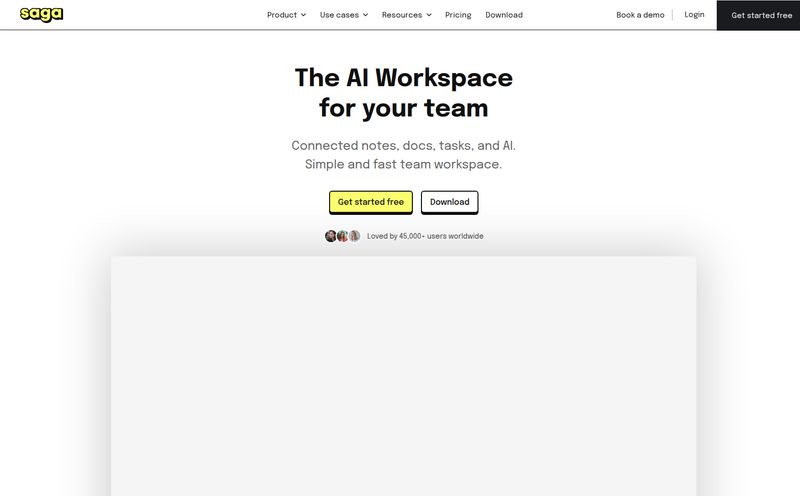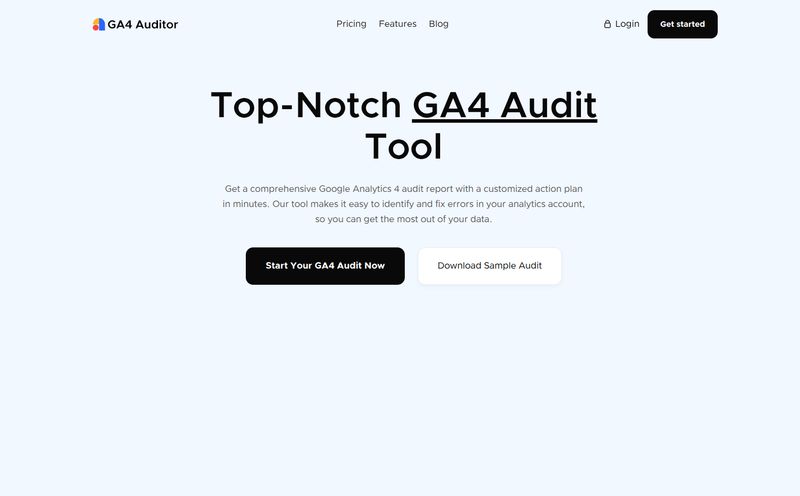If you've ever managed an IT project, you know the drill. You spend what feels like an eternity in meetings, trying to translate a vague business idea into a concrete set of requirements. You then spend even more time meticulously writing out user stories, acceptance criteria, and test cases until your fingers are numb and your brain feels like a wrung-out sponge. It’s the necessary grunt work that nobody actually enjoys.
For years, we’ve just accepted this as the cost of doing business. The tedious, manual foundation-laying before the real work can even begin. I've personally lost weeks of my life to spreadsheets and documents that tried to capture every possible edge case. So, when I hear about a tool that claims to use AI to automate this whole process, my ears perk up. But I’m also skeptical. We’ve seen a lot of AI hype lately, right?
The tool in the spotlight today is called Blueprint. It's making some bold claims about revolutionizing IT project planning. But does it live up to the hype? I decided to take a closer look.
What Exactly is Blueprint? (And Why Should You Care?)
Okay, so stripping away the marketing jargon, Blueprint is an AI-powered platform designed specifically for IT projects. Its whole reason for being is to take the most soul-crushing parts of project setup and put them on autopilot. Think of it like this: you feed it a high-level idea, and it spits out a ready-to-go project scope, complete with detailed user stories and even test cases for your QA team. It’s not a general-purpose task manager like Trello or Asana; it's a specialized beast built for the complexities of software development.
And honestly? It's about time. The amount of brainpower wasted on formatting user stories according to the perfect `"As a [user], I want to [action], so that [benefit]"` template is criminal. If an AI can handle that initial draft, it frees up project managers and business analysts to focus on what they're actually good at: strategy, stakeholder management, and solving real problems.

Visit Blueprint
The Bigger Picture: AI Creeping into Project Management
Blueprint isn't appearing in a vacuum. The trend of integrating artificial intelligence into productivity software is everywhere. We're seeing AI assistants pop up in everything from Notion to ClickUp. The Project Management Institute (PMI) has been talking about AI's impact for a while now. The goal is always the same: reduce manual effort, spot patterns humans might miss, and accelerate delivery.
Where Blueprint seems to be carving its niche is by not just being an AI feature, but by building the entire workflow around an AI core from the ground up, specifically for that IT project lifecycle. It’s an interesting and focused approach.
A Look Under the Hood at Blueprint's Core Features
So what does it actually do? I dug into its key capabilities to see where the magic happens.
From Hazy Idea to Concrete Scope
This is the starting point and probably the most impressive claim. You can input a business objective, and the AI will help you flesh it out into a structured project scope. This is a huge deal for fighting scope creep, that monster that lives under every project manager's bed. By defining the boundaries with AI assistance from day one, you create a stronger foundation and a clearer reference point for when stakeholders inevitably ask, "Could we just add one more thing?"
Automated Requirements and User Stories
This is the main event. This is the feature that made me go, "Okay, I'm listening." The platform generates the detailed requirements and agile user stories that form the backbone of any development sprint. In my experience, this is where projects either succeed or fail. Poorly written stories lead to confusion, rework, and frustrated developers. While the AI's output isn't going to be perfect (more on that later), getting a solid 80% of the way there in seconds instead of days is a massive win. It’s like having a hyper-efficient junior Business Analyst on your team who never needs a coffee break.
Test Case Generation – The Unsung Hero
I love this one because QA is so often an afterthought. Teams scramble to write test cases at the end of a sprint, often missing key scenarios. Blueprint's ability to generate test cases directly from the requirements ensures that quality is baked in from the start. It creates a clear link between what was asked for and how it will be validated. This feature alone could save teams countless hours and prevent so many of those "But it worked on my machine!" arguments.
The Good, The Bad, and The AI-Generated
No tool is perfect. After my analysis, here’s my balanced take. The platform is incredibly promising, offering comprehensive coverage from start to finish and tools that genuinely seem to help team collaboration. The sheer potential for time-saving through AI automation is its biggest selling point. It’s also built to be scalable, which is great for growing teams.
But let's have a reality check. You can't just plug this thing in and fire your project team. There's going to be a learning curve. This is a specialized tool, not a simple to-do list app. More importantly, you have to approach the AI with a healthy dose of skepticism. Think of the AI as a brilliant but sometimes naive intern. It will do the heavy lifting, but it needs a seasoned human—that's you—to review its work, add nuance, and catch context it might have missed. Blindly trusting its output without oversight is a recipe for disaster. The AI is a powerful assistant, not a replacement for your professional judgment.
Finally, its laser focus on IT projects is both a strength and a weakness. If you're running a software development team, it’s tailored for you. If you're a marketing agency trying to manage a campaign... this ain't it, chief. You'd be better off with a more generalist tool.
What's the Damage? A Look at Blueprint's Pricing
This is the part of the review where I usually break down the pricing tiers. So I went looking for Blueprint's pricing page, and... well, it appears to have gone on vacation. The link was broken, leading to a classic 404-style error page. Now, as someone who works on the web, I get it. Things break, pages get moved, especially with newer platforms. It's a small bump in the road, but an authentic one!
The lack of public pricing tells me they're likely operating on an enterprise, "contact us for a quote" model. This usually means it's priced based on team size, feature sets, and support levels. Don't expect a simple $10/month plan. You'll need to reach out to them directly for a demo and a customized quote. It’s not my favorite model, but it’s common for specialized B2B software.
Who is This Tool Actually For?
So, who should be booking a demo right now?
In my opinion, the ideal Blueprint user is a Business Analyst, Product Owner, or IT Project Manager working in an agile environment. If your days are filled with backlog grooming, sprint planning, and requirements gathering for software projects, this tool is speaking your language. Development agencies managing multiple complex client projects could also see a huge return on investment here.
On the flip side, if you're a freelancer, a small team managing non-technical projects, or you just need a place to track simple tasks, this is probably overkill. Stick with the tried-and-true tools that are built for that purpose.
So, is Blueprint the Future for IT Projects?
I’m cautiously optimistic. Blueprint is a powerful, highly specialized tool that tackles a very real, very annoying problem in the IT world. It’s not a magic wand, and it requires a smart human operator to get the most out of it. But its core promise—to automate the tedious documentation and free up humans to do more valuable work—is incredibly compelling.
If your team is drowning in requirements docs and user story backlogs, Blueprint is absolutely worth investigating. It represents a smart evolution in project management software, one that leans into AI's strengths without trying to pretend it can do everything. It might just be the blueprint (sorry, had to) for a more efficient and less frustrating way to build software.
Frequently Asked Questions
Is Blueprint easy to use?
Not exactly. As a specialized platform, it has a steeper learning curve than a general task manager. Expect to invest some time in setup and training to get the full benefit.
Can I trust the AI's output completely?
No, and you shouldn't with any AI tool. The AI provides an excellent first draft, but it requires human oversight, review, and refinement to ensure accuracy and capture business nuance.
Does Blueprint work for non-IT projects?
It's not designed for them. Its features are highly tailored to the software development lifecycle, including user stories and test cases. Marketing or construction teams would find it ill-suited to their needs.
How much does Blueprint cost?
Pricing is not publicly listed on their website. You need to contact their sales team for a demo and a custom quote based on your organization's needs.
What is the single biggest benefit of using Blueprint?
The massive time savings achieved by automating the generation of requirements, user stories, and test cases. This allows your team to move faster and focus on higher-value strategic tasks.
How does Blueprint compare to tools like Jira?
Blueprint focuses on the pre-development and planning phase (ideation, scope, requirements), whereas Jira is primarily focused on the development workflow and issue tracking. They could potentially be used together, with Blueprint feeding well-defined stories into a Jira backlog.
Reference and Sources
- PMI - AI Innovators: Powering Project Success
- Forbes - The Role Of AI In The Future Of Project Management
- (Note: The official product and pricing pages for Blueprint were inaccessible at the time of writing, but their main site can likely be found via a web search.)



